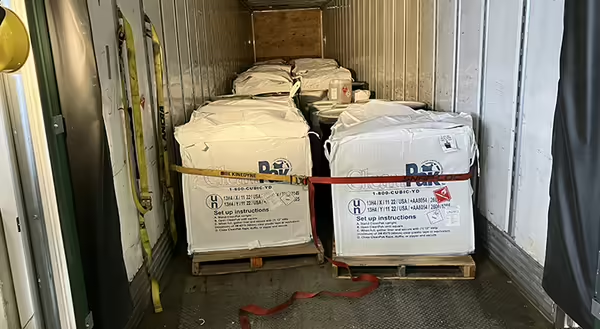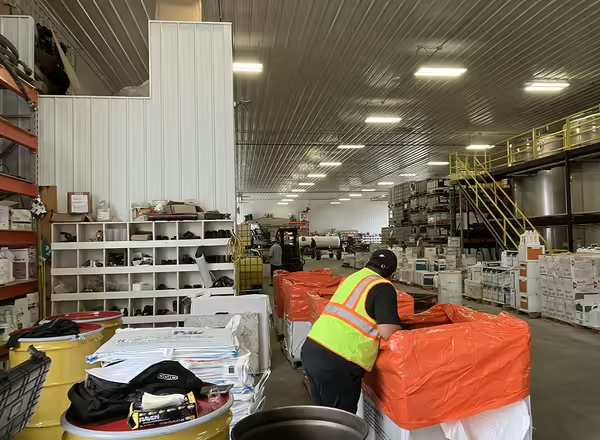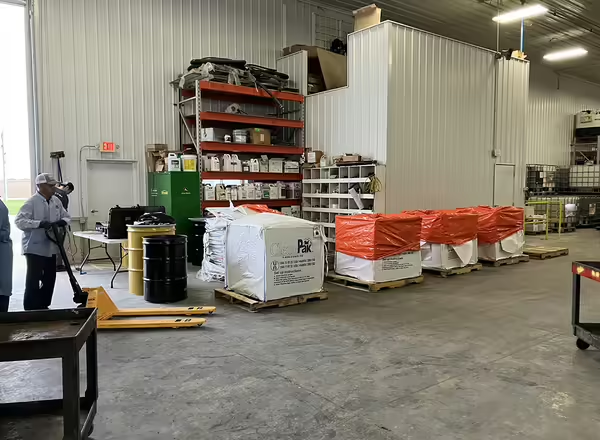
In 2023, the Illinois Department of Agriculture along with the Illinois Department of Public Health conducted an agricultural/structural pesticide clean sweep program collection for the residents of Bond, Clinton, Fayette, Jersey, Macoupin, Madison, Marion, Monroe, Montgomery, and St. Clair counties. Local sponsors included county Farm Bureau offices, University of Illinois Extension offices and Soil and Water Conservation District offices.
The collection was held on September 21, 2023 at the Effingham Equity facility in Greenville, IL. Of the 64 registered participants, 47 registered participants brought in a total of 14,262 pounds of unwanted pesticides to the collection. The single day collection was a success. Eight participants requested that their products be included on the 2024 collection. Three participants were asked to hold their products until the 2024 collection to prevent the program from going over budget. Six participants found other disposal services or were able to hand their products off to another applicator.
All chemicals collected during this program were registered with the Department prior to the actual collection date. By pre-registering the products, the Department was able to determine which products were eligible for collection. The majority of products turned away from the collection were not pesticides. These items included crop oil, surfactants, stickers, foaming agents, etc. Each participant received a response letter indicating the time, date, and location of the collection along with a listing of their chemicals which were to be brought to the collection for disposal.
Tradebe Environmental Services, LLC. was the Department of Agriculture's contractor for this year's collection. They collected waste from 8:30 a.m. until 2:45 p.m. No accidents or spills occurred during the collection. Tradebe Environmental Services, LLC. certifies that all chemicals were handled in compliance with all applicable local, state, and federal laws and regulations.
Following are approximate totals of some of the active ingredients that were collected:

- 2,447 pounds of compounds containing atrazine
- 70 pounds of compounds containing 2, 4-D
- 563 pounds of compounds containing acetochlor
- 32 pounds of compounds containing azoxystrobin
- 77 pounds of compounds containing bentazon
- 90 pounds of compounds containing captan
- 85 pounds of compounds containing carbaryl
- 379 pounds of compounds containing carbofuran
- 7 pounds of compounds containing chlordane
- 46 pounds of compounds containing chlorothalonil
- 479 pounds of compounds containing chlorpyrifos
- 56 pounds of compounds containing clethodim
- 228 pounds of compounds containing cyfluthrin

- 51 pounds of compounds containing dicamba
- 46 pounds of compounds containing dicofol
- 123 pounds of compounds containing dimethyl
- 139 pounds of compounds containing dimethylethyl
- 153 pounds of compounds containing fomesafen
- 568 pounds of compounds containing glyphosate
- 68 pounds of compounds containing imidacloprid
- 21 pounds of compounds containing imazethapyr
- 59 pounds of compounds containing lactofen
- 54 pounds of compounds containing malathion
- 43 pounds of compounds containing mesotrione
- 136 pounds of compounds containing maneb
- 405 pounds of compounds containing metochlor
- 47 pounds of compounds containing metribuzin

- 64 pounds of compounds containing norflurazon
- 41 pounds of compounds containing pendimethalin
- 1,573 pounds of compounds containing paraquat
- 32 pounds of compounds containing permethrin
- 86 pounds of compounds containing sethoxydim
- 77 pounds of compounds containing simazine
- 214 pounds of s-metolachlor
- and 1,697 pounds of trifluralin.
Source: Rick Severns, Environmental Engineer, Bureau of Environmental Programs, Illinois Department of Agriculture
ABOUT THE AUTHOR: Michelle Wiesbrook provides subject matter expertise and training in pesticide safety with an emphasis on horticultural weed science. She serves as the Illinois Pesticide Review newsletter editor, collecting and organizing material; and co-coordinates social media information for the PSEP program and ensures its timely publication.